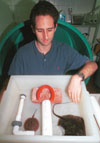 A University of Florida doctoral
student is using a $102,000 graduate research fellowship from the U.S.
Environmental Protection Agency to study why a stingray found throughout
much of Floridaís St. Johns River is the only one in North America able
to spend its entire life in freshwater.
A University of Florida doctoral
student is using a $102,000 graduate research fellowship from the U.S.
Environmental Protection Agency to study why a stingray found throughout
much of Floridaís St. Johns River is the only one in North America able
to spend its entire life in freshwater.
Zoology doctoral student Peter Piermarini is probing this capability in hopes of giving scientists an easy way to discern exclusively freshwater stingrays from ones that can tolerate both freshwater and saltwater. It is important to identify the freshwater rays first because they are more vulnerable to fishing and pollution than their more adaptable counterparts, Piermarini says.
"We canít save everything, so which ones are we going to prioritize?," he asks. "If a stingray is restricted to a freshwater environment, it should be prioritized over stingrays that move back and forth between freshwater and saltwater."
Scientists have identified more than two dozen species of freshwater rays in Latin America and another dozen or more rays that may venture into freshwater worldwide, says George Burgess, a UF ichthyologist. These include a ray with a reported 12-foot wingspan that lives in parts of Thailand and the Ganges River in India and several species that live in coastal rivers or lakes in West Africa and Southeast Asia.
 While
their remote habitats make many of these other freshwater species difficult
to study, the Dasyatis sabina ray Piermarini is studying is common in the
St. Johns River.
While
their remote habitats make many of these other freshwater species difficult
to study, the Dasyatis sabina ray Piermarini is studying is common in the
St. Johns River.
"Itís one of the only places in the world where these rays spend their entire lives in freshwater and where you can study them easily," he says.
The ray is brown on top, white on the bottom and can weigh 2 pounds or more. It is the same species of ray common along both coasts of Florida known to temporarily enter freshwater. Although the ray can live exclusively in freshwater, it normally lives in brackish water throughout its range in the St. Johns.
Most fish are confined either to freshwater or saltwater because of the way they regulate the amount of salt in their bodies. Saltwater seeks to move from an area of higher concentration to one of lower concentration. Ocean water is saltier than the fluid in saltwater fish, so their bodies have evolved to excrete salts. Freshwater fish, by contrast, have evolved to absorb salts from the environment.
A small number of fish, and an even smaller number of sharks, skates and rays, can migrate between fresh and salt water or live equally well in both. The object of Piermariniís research is to understand how the St. Johns River ray manages this feat. Scientists know fish use their gills to regulate the salt and water concentrations in their bodies, and much of Piermariniís work involves examining under powerful microscopes the biochemistry and cellular composition of gill material from rays.
Piermarini also is studying a South American ray that can live only in freshwater. When both studies are completed, he expects to have data other scientists can use to identify a given ray as restricted or unrestricted to freshwater.
Piermarini says rays are particularly threatened because, like sharks and skates, they are live-bearing and give birth to only a few young.
"It takes a lot of time to do the experiments in the places where these animals are threatened," he says. "It would be better if we could just go there, take a little bit of gill tissue and bring that back to the lab and analyze it."
Related web site:
http://nersp.nerdc.ufl.edu/~pmpie/